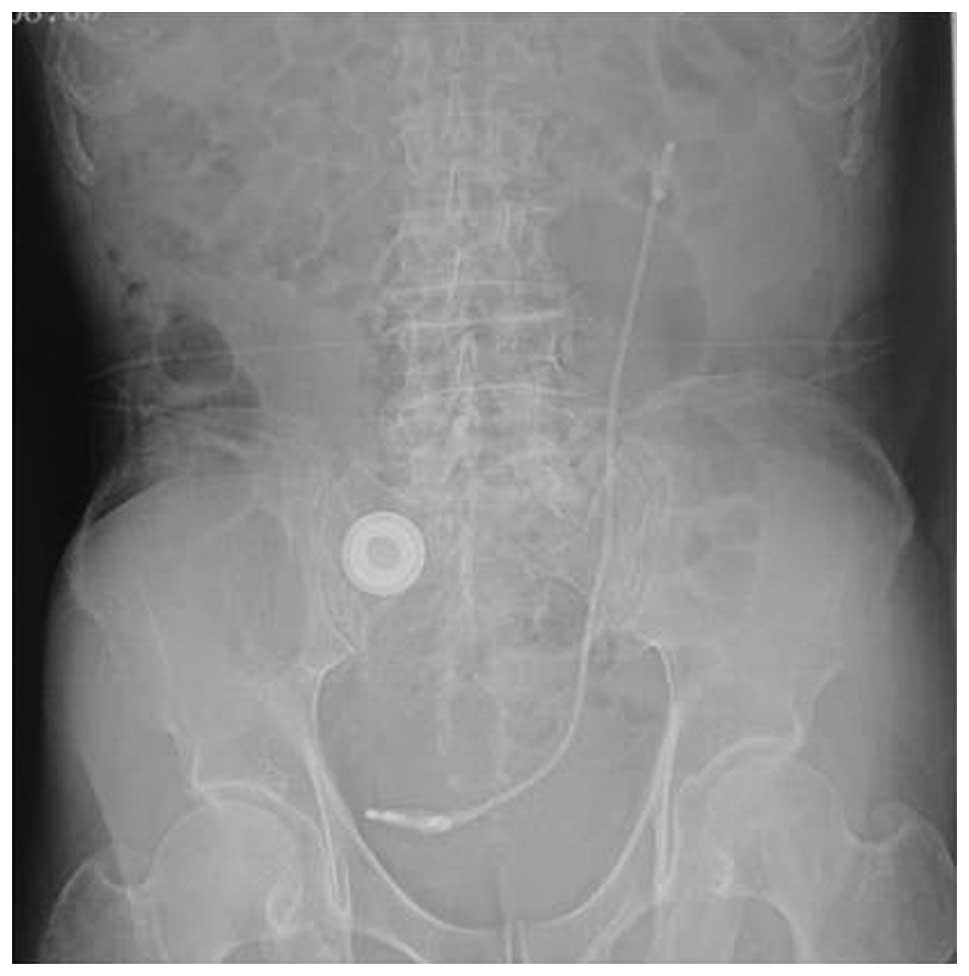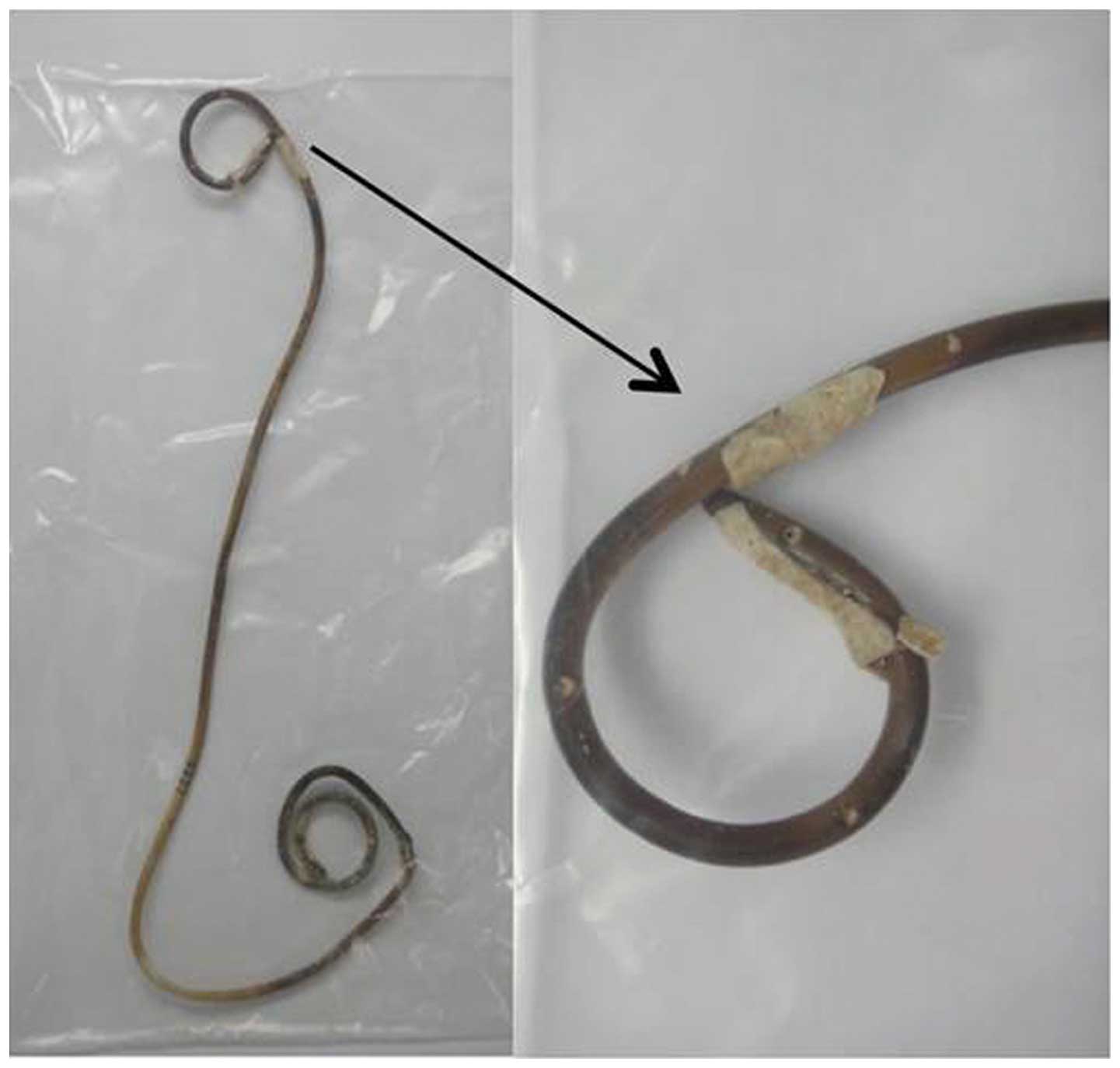Introduction
Ureteral stents are frequently used equipment in
urology, and are basic but specially designed hollow tubes that are
placed in the ureter. Stents with different diameters or gauges are
used in adult patients to fit different sized ureters. Three
different types of stents, including artificial polymeric stents,
ureteral stents, metallic ureteral stents and degradable ureteral
stents, are widely used in urologic procedures (1,2).
Ureteral stents, particularly double-J (D-J) stents, are widely
used in endourologic procedures to relieve obstruction, pain and
infection during urologic procedures (3). These stents should be removed within a
safe time frame by endourologic or other auxiliary techniques
(4). Keeping a stent in the ureter
for a long period of time carries a risk of microorganisms
developing a biofilm on the stent surface. Serious complications
may arise if a stent is not removed within 3 months, such as
encrustation, hematuria and infection (5). Recently, multiple endourological
approaches and open surgery have been developed to remove the
stents in patients with stent-related complications. An
endourological procedure is widely accepted for removing ureteral
stents, which is more efficient with less wound complications and
shorter recovery times than open surgery (6,7). The
present study reports a rare case of a patient with a coiled D-J
stent which was not removed for 6 years, which resulted in the
development of encrustation and was extracted successfully by
cystourethroscopy with holmium laser lithotripsy.
Case report
An 88-year-old man was admitted to the Department of
Urology, Pudong New Area Gongli Hospital (Shanghai, China) on 6th
May 2006 with complaints of urinary frequency and urgency, dysuria
and intermittent fever (maximum temperature, 38.3°C) lasting 1
week. Approximately 6 years prior, the patient had undergone
simultaneous radical resection of sigmoid colon cancer and partial
resection of the bladder. At that time, a D-J stent (Cook Ireland,
Ltd., Limerick, Ireland) was inserted to prevent transient urinary
tract obstruction and postoperative flank pain from ureteral edema
and blood clots. Informed consent was obtained from the patient to
report this case. A follow-up appointment had been arranged, which
the patient did not attend. The present study was approved by the
ethics committee of Pudong New Area Gongli Hospital.
Physical examination at admission was unremarkable
except for a previous surgical scar. Hematological and biochemical
investigations (8), including a
blood, urinary and renal function test, were also unremarkable,
with a white blood cell count of 7.4×109/l (normal,
3.5–9.5×109 cells/l), 72.3% neutrophils (normal, 50–70%)
and a serum creatinine level of 147 µmol/l (normal, 41–144 µmol/l).
Urinalysis (UF-100 automated urinalysis analyzer; Koehler
Instrument Company, Inc., New York, NY USA) (9) revealed pyuria (105 white blood
cells/high-powered field). Urine cultures were positive for
Enterococcus faecalis (Group D Streptococcus system),
Escherichia coli and Aeromonas hydrophila, which were
sensitive to penicillin (Suzhou Erye Pharmaceutical Co., Ltd.,
Suzhou, China) and kanamycin (Zhejiang Shapuaisi Pharmaceutical
Co., Ltd., Zhejiang, China). Kidney ureter bladder (KUB) X-ray
examination revealed the presence of an entire coiled D-J stent
from the kidney to the bladder (Fig.
1). Computed tomography (CT) urography scans demonstrated left
hydronephrosis and an encrusted D-J stent with calculi on the
vesical coil (Fig. 2).
Following treatment of the urinary tract infection
(UTI) with penicillin and kanamycin, cystoscopy (22 FSTORZ;
Karl-Storz GmbH & Co., KG, Tittlingen, Germany) was performed
with holmium laser lithotripsy (Cohernt Inc., Santa Clara, CA, USA)
under spinal anesthesia to remove the D-J stent. However, this
procedure failed as the stent was curled at one end and coated with
a calcified encrustation in the left ureter. Under an irrigation
pressure of 40 cm H2O, an 8/9.5F STORZ ureteroscope
(Karl-Storz GmbH & Co., KG) was placed into the bladder.
Encrusted stones surrounding the D-J stent, in particular in the
upper coil, were disintegrated with 2J/8HZ holmium laser
lithotripsy. The D-J stent was removed into the bladder. An intact
D-J ureteral stent, which was coated with yellow calculus, was
withdrawn from the bladder using a grasper under cystoscopy
(Fig. 3). The bladder was washed
with saline to clear the stones completely. The whole procedure for
D-J stent removal took 45 min.
Postoperatively, the antibiotic regimen was changed
to vancomycin (Vianex S.A., Athens, Greece), on the basis of the
sensitivity of the bacterial culture of the stones
(Staphylococcus haemolyticus). One week later, the patient
remained in good health and free of infection. The patient was
discharged 14 days after admission to the hospital (20th May 2006).
The postoperative period was uneventful, and the patient developed
no complications by the end of the 1-month follow-up period.
Discussion
The D-J ureteral stent is one of the most basic and
valuable tools used to prevent obstruction of the urinary tract and
to maintain its patency following endourological procedures and
urologic open surgery (9). The D-J
stent enables direct drainage of the upper urinary tract into the
bladder without the need for an external diversion (10). Complications of short-term stent
placement (3–9 weeks) include flank pain and irrigative voiding
symptoms, hematuria, dysuria, frequency, and suprapubic pain
(11). Complications may also occur
following the long-term placement of stents in patients who do not
attend the follow-up. These delayed complications include stenturia
and hydronephrosis, encrustation, blockage, impaction, migration,
knotting, fracture and spontaneous fragmentation of the stent
(12,13). As the use of indwelling ureteral
stents has increased, stent-associated infections have become more
frequent (14). Bacterial stent
colonization by multiple pathogens starts at 2 weeks and is
followed by UTI (15). Enterococcus
species and E. coli are the main causative pathogens and can
spread rapidly (16).
Stent encrustation is common in the use of long-term
ureteral stents. Ureteral stents that are left in place for >6
months are commonly encrusted (17–19). In
the present case, the stent was in situ for 6 years, and the
patient developed stone formation, encrustation and UTI. Numerous
previous studies have reported various multimodal endourologic
approaches to remove encrusted and retained stents, including
extracorporal shockware lithotripsy, ureteroscopy with or without
intracorporal retrieval, and percutaneous nephrolithotmy (20–22). For
long-term D-J stents with severe encrustation, ureteroscopy in
combination with holmium laser lithotripsy could represent an
alternative, minimally invasive treatment option (4). In the present study, cystourethroscopy
with holmium laser lithotripsy was used to manage the potentially
life-threatening complications by extracting the stent.
When a D-J stent must be used, the patient should be
educated about the need for its timely removal, and provided with
detailed information about stent removal. Contact information for
the patient should be recorded, to avoid unnecessary patient
morbidity and potential legal problems. Close patient monitoring
could reduce the possibility of leaving a stent in situ. The
current study suggested that cystourethroscopy with holmium laser
lithotripsy may be an effective and less invasive method for
removing encrusted D-J stents that have been in place for a long
time.
References
|
1
|
Elsamra SE, Leavitt DA, Motato HA,
Friedlander JI, Siev M, Keheila M, Hoenig DM, Smith AD and Okeke Z:
Stenting for malignant ureteral obstruction: Tandem, metal or
metal-mesh stents. Int J Urol. 22:629–636. 2015. View Article : Google Scholar : PubMed/NCBI
|
|
2
|
Fiuk J, Bao Y, Calleary JG, Schwartz BF
and Denstedt JD: The use of internal stents in chronic ureteral
obstruction. J Urol. 193:1092–1100. 2015. View Article : Google Scholar : PubMed/NCBI
|
|
3
|
Haleblian G, Kijvikai K, de la Rosette J
and Preminger G: Ureteral stenting and urinary stone management: A
systematic review. J Urol. 179:424–430. 2008. View Article : Google Scholar : PubMed/NCBI
|
|
4
|
Xu C, Tang H, Gao X, Gao X, Yang B and Sun
Y: Management of forgotten ureteral stents with holmium laser.
Lasers Med Sci. 24:140–143. 2009. View Article : Google Scholar : PubMed/NCBI
|
|
5
|
Olvera-Posada D, Suárez-Santos M,
Castillejos-Molina R, Gabilondo-Navarro F and Méndez-Probst CE:
Validation of the Spanish version of Ureteral Stent Symptom
Questionnaire: Prevalence of symptoms in a tertiary care center in
Mexico. J Endourol. 28:377–382. 2014. View Article : Google Scholar : PubMed/NCBI
|
|
6
|
Murthy KV, Reddy SJ and Prasad DV:
Endourological management of forgotten encrusted ureteral stents.
Int Braz J Urol. 36:420–429. 2010. View Article : Google Scholar : PubMed/NCBI
|
|
7
|
Bostanci Y, Ozden E, Atac F, Yakupoglu YK,
Yilmaz AF and Sarikaya S: Single session removal of forgotten
encrusted ureteral stents: Combined endourological approach. Urol
Res. 40:523–529. 2012. View Article : Google Scholar : PubMed/NCBI
|
|
8
|
Hunt L, Gupta-Wright A, Simms V, Tamba F,
Knott V, Tamba K, Heisenberg-Mansaray S, Tamba E, Sheriff A, Conteh
S, et al: Clinical presentation, biochemical, and haematological
parameters and their association with outcome in patients with
Ebola virus disease: an observational cohort study. Lancet Infect
Dis. 15:1292–1299. 2015. View Article : Google Scholar : PubMed/NCBI
|
|
9
|
Lumma PP, Schneider P, Strauss A, Plothe
KD, Thelen P, Ringert RH and Loertzer H: Impact of ureteral
stenting prior to ureterorenoscopy on stone-free rates and
complications. World J Urol. 31:855–859. 2013. View Article : Google Scholar : PubMed/NCBI
|
|
10
|
Matani YS, Al-Ghazo MA, Al-azab RS,
Bani-hani O and Rabadi DK: Emergency double-J stent insertion
following uncomplicated Ureteroscopy: Risk-factor analysis and
recommendations. Int Braz J Urol. 39:203–208. 2013.PubMed/NCBI
|
|
11
|
Ringel A, Richter S, Shalev M and
Nissenkorn I: Late complications of ureteral stents. Eur Urol.
38:41–44. 2000. View Article : Google Scholar : PubMed/NCBI
|
|
12
|
Bhuiyan ZH, Bhuiyan NI, Khan SA, Tawhid MH
and Islam MF: Forgotten urological stent. Mymensingh Med J.
20:632–639. 2011.PubMed/NCBI
|
|
13
|
Wani B, Upadhey R, Rathod V and Bhole A:
Forgotten long-term indwelling doubl' J stent. Saudi J Kidney Dis
Transpl. 23:1043–1045. 2012. View Article : Google Scholar : PubMed/NCBI
|
|
14
|
Pengfei S, Yutao L, Jie Y, Wuran W, Yi D,
Hao Z and Jia W: The results of ureteral stenting after
ureteroscopic lithotripsy for ureteral calculi: A systematic review
and meta-analysis. J Urol. 186:1904–1909. 2011. View Article : Google Scholar : PubMed/NCBI
|
|
15
|
Aydin HR, Irkilata L, Aydin M, Gorgun S,
Demirel HC, Adanur S, Keles M, Atilla A and Atilla MK: Incidence of
bacterial colonisation after indwelling of double-J ureteral stent.
Arch Ital Urol Androl. 87:291–294. 2016. View Article : Google Scholar : PubMed/NCBI
|
|
16
|
Soyupek S, Oksay T and Koşar A:
Fragmentation of a forgotten double J stent and excreted with
urine: Case report. Int Urol Nephrol. 35:91–92. 2003. View Article : Google Scholar : PubMed/NCBI
|
|
17
|
Tsai CC, Shen JT, Huang SP, Chang SF, Tsai
LJ, Wu WJ and Huang CH: Use of a holmium laser to treat a forgotten
double-J stent with whole stent encrustations: A case report.
Kaohsiung J Med Sci. 25:567–571. 2009. View Article : Google Scholar : PubMed/NCBI
|
|
18
|
Ignjatovic I and Stojkovic I: Trapping of
the double-J stent in the urinary tract eight years after
extracorporeal shock wave lithotripsy. Int Urol Nephrol. 32:29–31.
2000. View Article : Google Scholar : PubMed/NCBI
|
|
19
|
Singh V, Srinivastava A, Kapoor R and
Kumar A: Can the complicated forgotten indwelling ureteric stents
be lethal? Int Urol Nephrol. 37:541–546. 2005. View Article : Google Scholar : PubMed/NCBI
|
|
20
|
Borboroglu PG and Kane CJ: Current
management of severely encrusted ureteral stents with a large
associated stone burden. J Urol. 164:648–650. 2000. View Article : Google Scholar : PubMed/NCBI
|
|
21
|
Bultitude MF, Tiptaft RC, Glass JM and
Dasgupta P: Management of encrusted ureteral stents impacted in
upper tract. Urology. 62:622–626. 2003. View Article : Google Scholar : PubMed/NCBI
|
|
22
|
Lam JS and Gupta M: Tips and tricks for
the management of retained ureteral stents. J Endourol. 16:733–741.
2002. View Article : Google Scholar : PubMed/NCBI
|

















